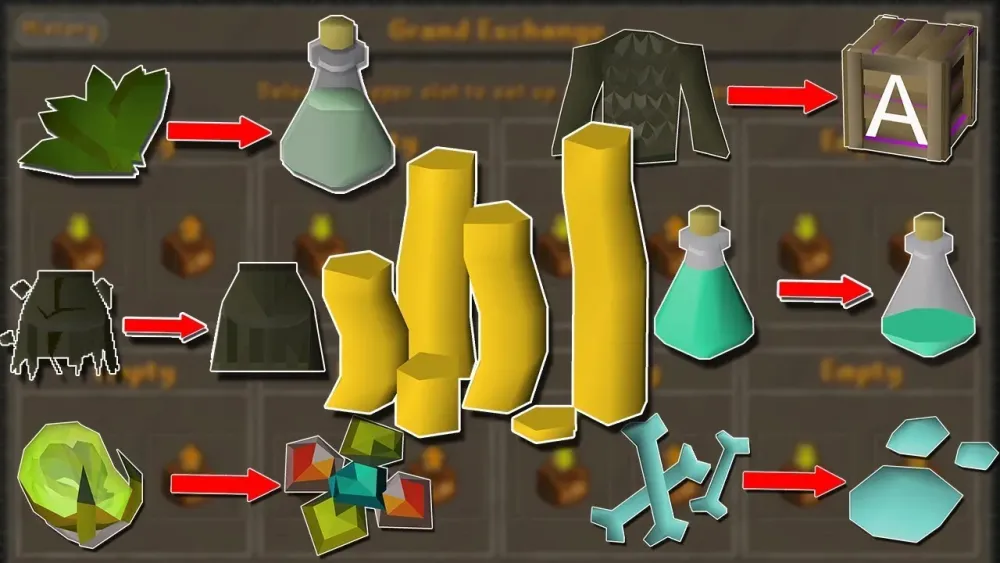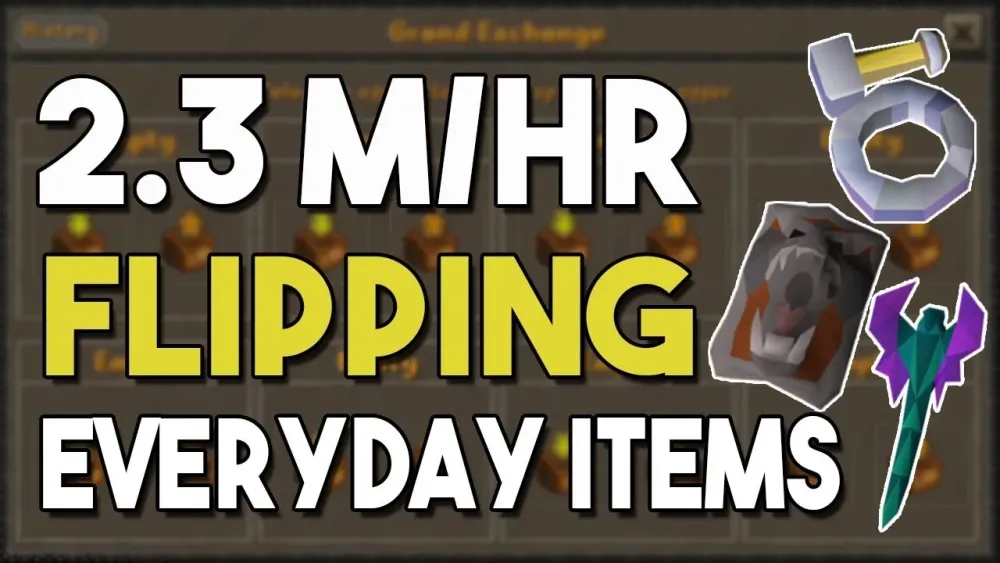Your cart is empty
How to Flip in OSRS – Ultimate Guide to Making Millions

Flipping in Old School RuneScape (OSRS) is one of the most effective ways to make millions of gold without relying on combat or skilling. It involves buying items low and selling them high on the Grand Exchange, capitalizing on market trends and price fluctuations. Whether you’re a beginner with a small cash stack or a seasoned player looking to maximize profits, this guide will walk you through the art of flipping in OSRS. From understanding the basics to advanced strategies, we’ll cover everything you need to know to succeed in the Grand Exchange market.
Flipping is a merchanting technique where players buy items at a lower price and sell them at a higher price to make a profit. The Grand Exchange (GE) serves as the central marketplace in OSRS, making it the perfect platform for flipping. Unlike other money-making methods that require hours of grinding, flipping relies on market knowledge, patience, and strategic timing. It’s accessible to all players, regardless of combat level or skill requirements, making it an attractive option for building wealth.
Why Flip in OSRS?
Flipping offers several advantages over traditional money-making methods:
- Low Time Investment: Flipping can be done in short bursts, perfect for players with limited playtime.
- Scalable Profits: The more gold you invest, the higher your potential returns.
- No Skill Requirements: You don’t need high combat or skilling levels to start.
- Market Control: With knowledge, you can influence prices and maximize margins.
Is Flipping Risky?
While flipping is generally low-risk compared to PvM or staking, it’s not without challenges. Prices can crash unexpectedly, and misjudging the market can lead to losses. However, with proper research and cautious strategies, you can minimize risks and ensure consistent profits.
Getting Started with Flipping

Before diving into the Grand Exchange, you need to prepare. Flipping doesn’t require much setup, but a few key steps will set you up for success.
Understand the Grand Exchange Mechanics
The Grand Exchange operates on a supply-and-demand system with buy and sell limits for each item. Every four hours, you’re limited to buying a certain quantity of an item (e.g., 125 for most weapons, 10,000 for runes). Knowing these limits is crucial for planning your flips. Additionally, the GE has a 5% price fluctuation cap per day, which affects how quickly prices can rise or fall.
Start with a Cash Stack
Your starting gold determines the scale of your flips. Beginners can start with as little as 100k gold, while players with millions can aim for high-value items. A good rule of thumb is to diversify your investments to avoid tying up all your gold in one item.
Tools for Flipping
Several tools can help you track prices and identify profitable items:
- GE Tracker: A website that shows real-time price trends and profit margins.
- OSRS Wiki: Provides buy/sell limits and historical price data.
- RuneLite Plugin (GE-Tracker): Integrates market data directly into your game client.
Step-by-Step Flipping Process

Flipping may seem daunting at first, but breaking it down into clear steps makes it manageable. Here’s how to execute a successful flip.
Step 1: Research the Market
Start by identifying items with high trading volume and stable margins. Popular categories include:
- Consumables: Potions, food, and runes (e.g., Saradomin brews, cosmic runes).
- Skilling Supplies: Ores, logs, and herbs (e.g., runite ore, yew logs).
- Gear: Mid-tier weapons and armor (e.g., dragon scimitar, black d’hide).
Use GE Tracker to check an item’s buy/sell prices and margin. For example, if an item buys instantly at 1,000 gp and sells at 1,200 gp, your margin is 200 gp per item (minus a 1% GE tax).
Step 2: Test the Market
Before committing your entire cash stack, test the item’s liquidity. Buy one unit at the lowest price and sell it at the highest price. If both transactions complete quickly, the item is a good candidate for flipping. Avoid items with slow buy/sell times, as they tie up your gold.
Step 3: Place Bulk Orders
Once you’ve confirmed a profitable item, buy in bulk within your budget. For example, if you have 1M gold and the item’s buy price is 1,000 gp, buy 1,000 units. Immediately list them for sale at your target sell price (e.g., 1,200 gp). Be patient, as some flips may take hours to complete.
Step 4: Monitor and Adjust
Check your offers periodically. If an item isn’t selling, lower your sell price slightly. If it’s selling too fast, you might be underpricing—raise it to capture more profit. Use tools like GE Tracker to stay updated on price trends.
Advanced Flipping Strategies
Once you’ve mastered basic flipping, you can explore advanced techniques to boost your profits. These require more time and market knowledge but offer higher rewards.
High-Volume Flipping
Focus on items with massive trading volume, like runes or arrows. These items have smaller margins (e.g., 1-5 gp per unit) but can be flipped in huge quantities (e.g., 10,000 units). For example, flipping 10,000 fire runes at a 3 gp margin yields 30,000 gp per flip.
Overnight Flipping
Place buy orders for items at slightly below market price before logging off. When you log back in, sell them at or above market price. This passive strategy works well for items with predictable demand, like potions or food.
Event-Based Flipping
Capitalize on OSRS events, updates, or new content releases. For example, if a new boss is introduced, items like specific potions or gear may spike in demand. Buy these items early and sell them when prices peak. Follow OSRS news on the official website or X posts to stay informed.
Price Manipulation (Ethical Considerations)
Some players attempt to manipulate prices by buying out an item’s stock to create artificial scarcity, then selling at a higher price. While this can be profitable, it’s controversial and risky. Stick to ethical flipping to avoid potential bans or community backlash.
Common Flipping Mistakes to Avoid
Even experienced flippers make mistakes. Here are pitfalls to watch out for and how to avoid them.
Overinvesting in One Item
Putting all your gold into a single item increases risk. If the price crashes, you could lose millions. Diversify your flips across multiple items to spread the risk.
Ignoring GE Tax
The Grand Exchange imposes a 1% tax on sales (capped at 5M gp per transaction). Always factor this into your profit calculations. For example, a 1,000 gp margin becomes 990 gp after tax.
Chasing Hype
When an item’s price spikes due to hype (e.g., a new update), it’s tempting to buy in. However, prices often crash after the initial surge. Wait for stabilization before flipping hyped items.
Impatience
Flipping requires patience. If your offers aren’t completing instantly, don’t panic and undercut your prices drastically. Adjust gradually and stick to your strategy.
| Mistake | Consequence | Solution |
|---|---|---|
| Overinvesting | High risk of loss if price crashes | Diversify across multiple items |
| Ignoring Tax | Lower profits than expected | Calculate margins with 1% tax |
| Chasing Hype | Buying at peak, losing on crash | Wait for price stabilization |
| Impatience | Selling too low, missing profits | Adjust prices gradually |
Scaling Your Flipping Empire
As your cash stack grows, so do your opportunities. Here’s how to take your flipping to the next level.
Increase Investment Size
With millions in gold, you can flip high-value items like rare weapons (e.g., dragon warhammer) or bulk supplies (e.g., 1,000 Saradomin brews). These flips yield larger margins but require more market research.
Automate Tracking
Use RuneLite plugins or browser extensions to monitor multiple items simultaneously. Set alerts for price drops or spikes to act quickly on opportunities.
Build a Flipping Routine
Dedicate specific times each day to check offers, research items, and place new orders. Consistency is key to turning flipping into a reliable income source.
Flipping in OSRS is a dynamic and rewarding way to build wealth in Gielinor. By starting small, learning the market, and scaling strategically, you can turn a modest cash stack into millions. Avoid common pitfalls, stay patient, and use tools to stay ahead of the curve. Whether you’re flipping runes or rare gear, the Grand Exchange is your playground—go make those profits!
